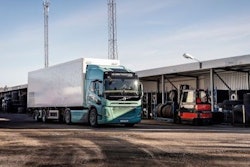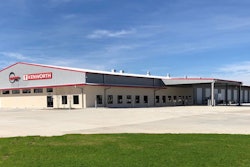 Fleet panelists discuss electric trucks at Heavy Duty Aftermarket Dialogue (HDAD) Monday in Grapevine, Texas.
Fleet panelists discuss electric trucks at Heavy Duty Aftermarket Dialogue (HDAD) Monday in Grapevine, Texas.After electric trucks dominated discussion between OE and aftermarket suppliers early Monday at Heavy Duty Aftermarket Dialogue (HDAD) in Grapevine, Texas, the fleet community responded with its take on the future of electrification in the trucking industry during Monday’s final session.
Featuring representatives from national carriers PepsiCo and Werner Enterprises and regional carriers Ploger Transportation and Bettendorf Trucking, Monday’s fleet panelists agreed with their supplier counterparts that electric trucks will make headway in the industry in the coming years. But it was where they differed — regarding duty cycle and adoption rates — that made Monday’s final session so illuminating.
PepsiCo’s Keshav Sondhi says his company has been electrifying its medium-duty fleet for nearly a decade. With a substantial number of dedicated urban routes and a longer than average trade cycle, Sondhi says PepsiCo turned to electric trucks because it saw an opportunity to get in on the ground floor of a new technology that could provide long-term ROI benefits. He says the technology has been valuable in some areas but also has presented its fair share of challenges, such as extreme payloads for beverage trucks and battery range reductions that occur in colder climates.
When asked about PepsiCo’s commitment to Class 8 electrification, Sondhi says the business does intend test out electric equipment in Central California where the routes and terrain are optimal but is not planning any nationwide adoption at this time.
Scott Reed with Werner Enterprises added his fleet took ownership of its first electric truck just two weeks ago. Reed says Werner is intrigued by electrification in optimal circumstances for its expanding number of dedicated routes — from 35 percent of routes four years ago to 60 percent today — but does not intend to add another electric truck at this time.
Conversely, Bob Phipps with Bettendorf Trucking says it’s unlikely his business will ever charge its equipment. As a logging and heavy materials hauler in the Pacific Northwest, Phipps says his fleet’s operating environment is strenuous enough for 15-liter diesel engines.
“We do a lot of work in areas where cell phones don’t work,” he says. “Not really good places to have to charge a truck.”
Monday’s discussion also touched on the topic conventional diesel engine displacement and how smaller engines are being perceived by the fleet community. Sondhi says PepsiCo is committed to a “flat plains” 11-liter engine spec for its equipment in the Midwest due to its weight and fuel economy benefits. He says the company suses larges engines in coastal or mountainous regions, though he also acknowledges the PepsiCo’s ROI potential for a smaller engine is larger than most OTR fleets because of how long it keeps its equipment.
Tanya Morrow says for companies with shorter trade cycles, like Ploger Transportation, smaller displacement engines can be a tough sell. Morrow says her company recently spec’d a weight-conscious 11-liter engine, 6×2 axle configuration that offered some substantial fuel savings, but says a lot of those savings were lost when the trucks hit the secondary market.
“We went back to the 13-liter for a resale perspective,” she says. “Acceptance [of smaller displacement engines] in the industry is not where the OEMs would like it to be.”
Other topics addressed Monday by the fleet panel included aftermarket parts preferences (each panelist preferred OE genuine or branded aftermarket equivalents for their equipment) and the challenges of outsourcing service — of which more information can be found in the video above.











